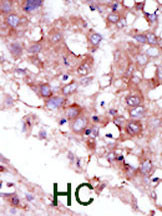STK33 Antibody (C-term)
Purified Rabbit Polyclonal Antibody (Pab)
- 产品详情
- 实验流程
- 背景知识
Application
| WB, IHC-P, E |
|---|---|
| Primary Accession | Q9BYT3 |
| Reactivity | Human |
| Host | Rabbit |
| Clonality | Polyclonal |
| Isotype | Rabbit IgG |
| Calculated MW | 57831 Da |
| Antigen Region | 476-506 aa |
| Gene ID | 65975 |
|---|---|
| Other Names | Serine/threonine-protein kinase 33, STK33 |
| Target/Specificity | This STK33 antibody is generated from rabbits immunized with a KLH conjugated synthetic peptide between 476-506 amino acids from the C-terminal region of human STK33. |
| Dilution | WB~~1:1000 IHC-P~~1:100~500 E~~Use at an assay dependent concentration. |
| Format | Purified polyclonal antibody supplied in PBS with 0.09% (W/V) sodium azide. This antibody is prepared by Saturated Ammonium Sulfate (SAS) precipitation followed by dialysis against PBS. |
| Storage | Maintain refrigerated at 2-8°C for up to 2 weeks. For long term storage store at -20°C in small aliquots to prevent freeze-thaw cycles. |
| Precautions | STK33 Antibody (C-term) is for research use only and not for use in diagnostic or therapeutic procedures. |
| Name | STK33 {ECO:0000303|PubMed:34155512} |
|---|---|
| Function | Serine/threonine protein kinase required for spermatid differentiation and male fertility (PubMed:37146716, PubMed:38781365). Promotes sperm flagella assembly during spermatogenesis by mediating phosphorylation of fibrous sheath proteins AKAP3 and AKAP4 (By similarity). Also phosphorylates vimentin/VIM, thereby regulating the dynamic behavior of the intermediate filament cytoskeleton (By similarity). |
| Cellular Location | Cytoplasm {ECO:0000250|UniProtKB:Q924X7}. Cytoplasm, cytoskeleton {ECO:0000250|UniProtKB:Q924X7}. Cytoplasm, perinuclear region {ECO:0000250|UniProtKB:Q924X7}. Note=Colocalizes with the caudal end of the manchette, a transient structure that guides tail elongation in elongating spermatids {ECO:0000250|UniProtKB:Q924X7} |
| Tissue Location | Highly expressed in testis, fetal lung and heart, followed by pituitary gland, kidney, interventricular septum, pancreas, heart, trachea, thyroid gland and uterus. Weak hybridization signals were observed in the following tissues: amygdala, aorta, esophagus, colon ascending, colon transverse, skeletal muscle, spleen, peripheral blood leukocyte, lymph node, bone marrow, placenta, prostate, liver, salivary gland, mammary gland, some tumor cell lines, fetal brain, fetal liver, fetal spleen and fetal thymus. No signal at all was detectable in RNA from tissues of the nervous system |
For Research Use Only. Not For Use In Diagnostic Procedures.
Provided below are standard protocols that you may find useful for product applications.
BACKGROUND
Protein kinases are enzymes that transfer a phosphate group from a phosphate donor, generally the g phosphate of ATP, onto an acceptor amino acid in a substrate protein. By this basic mechanism, protein kinases mediate most of the signal transduction in eukaryotic cells, regulating cellular metabolism, transcription, cell cycle progression, cytoskeletal rearrangement and cell movement, apoptosis, and differentiation. With more than 500 gene products, the protein kinase family is one of the largest families of proteins in eukaryotes. The family has been classified in 8 major groups based on sequence comparison of their tyrosine (PTK) or serine/threonine (STK) kinase catalytic domains.
REFERENCES
Blume-Jensen P, et al. Nature 2001. 411: 355.
Cantrell D, J. Cell Sci. 2001. 114: 1439.
Jhiang S Oncogene 2000. 19: 5590.
Manning G, et al. Science 2002. 298: 1912.
Moller, D, et al. Am. J. Physiol. 1994. 266: C351-C359.
Robertson, S. et al. Trends Genet. 2000. 16: 368.
Robinson D, et al. Oncogene 2000. 19: 5548.
Van der Ven, P, et al. Hum. Molec. Genet. 1993. 2: 1889.
Vanhaesebroeck, B, et al. Biochem. J. 2000. 346: 561.
Van Weering D, et al. Recent Results Cancer Res. 1998. 154: 271.
终于等到您。ABCEPTA(百远生物)抗体产品。
点击下方“我要评价 ”按钮提交您的反馈信息,您的反馈和评价是我们最宝贵的财富之一,
我们将在1-3个工作日内处理您的反馈信息。
如有疑问,联系:0512-88856768 tech-china@abcepta.com.























 癌症的基本特征包括细胞增殖、血管生成、迁移、凋亡逃避机制和细胞永生等。找到癌症发生过程中这些通路的关键标记物和对应的抗体用于检测至关重要。
癌症的基本特征包括细胞增殖、血管生成、迁移、凋亡逃避机制和细胞永生等。找到癌症发生过程中这些通路的关键标记物和对应的抗体用于检测至关重要。 为您推荐一个泛素化位点预测神器——泛素化分析工具,可以为您的蛋白的泛素化位点作出预测和评分。
为您推荐一个泛素化位点预测神器——泛素化分析工具,可以为您的蛋白的泛素化位点作出预测和评分。 细胞自噬受体图形绘图工具为你的蛋白的细胞受体结合位点作出预测和评分,识别结合到自噬通路中的蛋白是非常重要的,便于让我们理解自噬在正常生理、病理过程中的作用,如发育、细胞分化、神经退化性疾病、压力条件下、感染和癌症。
细胞自噬受体图形绘图工具为你的蛋白的细胞受体结合位点作出预测和评分,识别结合到自噬通路中的蛋白是非常重要的,便于让我们理解自噬在正常生理、病理过程中的作用,如发育、细胞分化、神经退化性疾病、压力条件下、感染和癌症。







